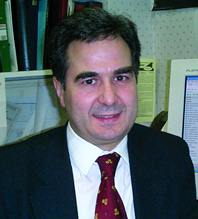A Tuesday morning ACR clinical symposium will outline efforts by researchers in the United Kingdom to identify RA treatment biomarkers.

The Pathogenesis of Rheumatoid Synovitis: Prospects for Advancing Therapeutics will focus on the role of synovial pathobiology in RA pathogenesis, disease evolution, and prognosis, according to presenter Costantino Pitzalis, MD, PhD, FRCP, Professor of Experimental Medicine and Rheumatology at William Harvey Research Institute, Queen Mary University of London. The talk also will emphasize the importance of bringing pathobiology to the development of a new taxonomy of disease based on disease mechanism rather than symptoms and signs.
Dr. Pitzalis said the presentation would include a discussion about the opportunity of using pathobiology to define different RA subsets and the relevance of this for novel target discovery, accelerating the development of the next generation of targeted therapies, and optimizing use of current biologics through a stratified medicine approach.
Another aspect of the talk will cover the development of ultrasound-guided synovial biopsy as a safe, well-tolerated procedure pioneered at the William Harvey Research Institute. The ultrasound-guided biopsy of synovial tissue is much less invasive and cheaper than the arthroscopic technique, Dr. Pitzalis said. Moreover, the procedure can be performed both by rheumatologists and radiologists.
The institute has already trained more than 30 fellows across Europe and has played host to more than a dozen U.S. physicians, as well some in China and Singapore.
Importantly, Dr. Pitzalis said, U.S.-guided biopsy enables the collection of high-quality synovial tissue from most patients and most joints large and small, enabling the performance of randomized clinical trials for the first time on a large, multi-center basis.
Searching for treatment biomarkers in the diseased tissue and testing the clinical utility of synovial pathobiology is the focus in appropriately powered randomized clinical trials, he said. Trying to identify predictors of response — currently non-existent — is an absolute requirement, as approximately 40 percent of patients do not respond to today’s biologic treatments.
In addition, the mechanisms of “non-response” are poorly understood, so physicians are not in the position to use these expensive drugs in a rational way except to “try and see.”
“This approach is really not tenable any longer both in terms of the financial implications for the payors and for patients who become exposed to potentially toxic drugs and which they may not respond to,” he said.
“The concept that we give a drug to a patient and we wait to see whether it responds or not is not the best way forward. It is not the way of practicing medicine in the 21st century.”
There are two clinical trials underway, one involving patients who have not responded to DMARDs, and the other involving patients not responding to TNF inhibitors. Data from the studies are at least two years away, Dr. Pitzalis said.
Demonstration of clinical utility in these trials may be a “game changer,” he said, “as it may address a major unmet need and improve our capacity to give the right drug to the right patient the first time, and at the moment, we don’t have the tools to do that.”
